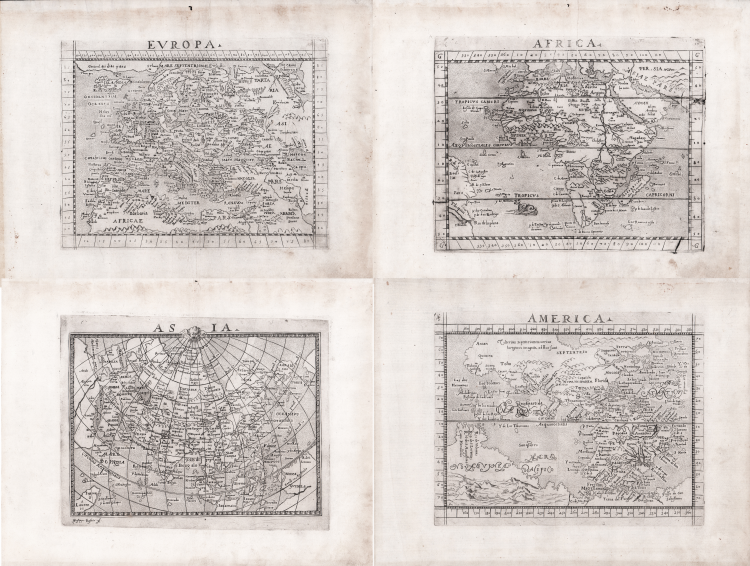











| Reference: | 4836 |
| Author | Giuseppe ROSACCIO |
| Year: | 1590 ca. |
| Zone: | The four continents |
| Printed: | Venice |
| Measures: | 260 x 210 mm |










| Reference: | 4836 |
| Author | Giuseppe ROSACCIO |
| Year: | 1590 ca. |
| Zone: | The four continents |
| Printed: | Venice |
| Measures: | 260 x 210 mm |
- EARLY ISSUE, UNRECORDED - Suite depicting the 4 continents, finely etched with etching and engraving, dating to 1590/95 approx. The map of Asia is signed in the plate, lower left. Magnificent proofs, rich tones, printed on contemporary laid paper with watermark "still in a circle surmounted by flower" with the countermark (Briquet 571, 178 Woodward), wide margins, in perfect condition
The maps, according to Philip Burden and Richard Betz, can be dated back to 1605 and are clearly derived from that published in the Universale Fabrica del Mondo by Giovanni Lorenzo Anania, Venice 1582. They differ mainly in size and scale of gradation.
However, we would disagree on the dating attributed by Burden and Betz, considering these works of Rosaccio dating from the period 1590/95. The maps were in fact accompanied by a map of the world that includes Rodney Shirley among those added to the new reissue of The Mapping of the World, listing only known specimen, which is located in the Municipal Library of Grenoble. Shirley dated the map at the last decade of the sixteenth century.
At the conclusion of the study of this unusual maps, we can that describe this set is a first issue of Rosaccio’s maps later incorporated in his "Geographia" and also in the Relationi Universali by Botero. The works, probably made in a few examples, were never included in any publication, and are on uncut sheets, with full margins, printed on paper with a watermark that indicates Briquet manufactured in Verona around 1583, and Woodward found in other maps of the period 1580 to 1594. There are also different sizes of plates, but this is probably because scholars have found to examine specimens trimmed in copper.
Homogeneous set of extraordinary rarity.
|
Burden, The Mapping of North America, 149; Shirley, The Mapping of the World, 174A, Betz, The Mapping of Africa, 51; Briquet, Les Filigranes, 571. Dimensioni circa 210x260 ognuna
|
Giuseppe ROSACCIO Pordenone circa 1530 – Venezia 1621
|
physician, travel writer, geographer, cosmographer and cartographer, he is known for some geographical and cosmographical works, which, although not large volume, brought him some fame and was reprinted several times. Among them the Teatro del Cielo e della Terra (Venezia 1595), Mondo e le sue parti, cioè Europa, Affrica, Asia et America (Verona 1596), il Microcosmo (Firenze 1600), iMondo elementare e celeste (Treviso 1604), il Discorso sulla nobiltà ed eccellenza della Terra (Firenze). He also supervised an edition of Ptolemy's Geography, printed in Venice in 1599, accompanied with some Discorsi and 42 new tables. He is also the author of a large map of the world (Venice 1597), a large map of Italy (Florence 1609) and one of Tuscany (Florence 1609). In all these works, however, shows little originality. (Almagià)
|
|
Burden, The Mapping of North America, 149; Shirley, The Mapping of the World, 174A, Betz, The Mapping of Africa, 51; Briquet, Les Filigranes, 571. Dimensioni circa 210x260 ognuna
|
Giuseppe ROSACCIO Pordenone circa 1530 – Venezia 1621
|
physician, travel writer, geographer, cosmographer and cartographer, he is known for some geographical and cosmographical works, which, although not large volume, brought him some fame and was reprinted several times. Among them the Teatro del Cielo e della Terra (Venezia 1595), Mondo e le sue parti, cioè Europa, Affrica, Asia et America (Verona 1596), il Microcosmo (Firenze 1600), iMondo elementare e celeste (Treviso 1604), il Discorso sulla nobiltà ed eccellenza della Terra (Firenze). He also supervised an edition of Ptolemy's Geography, printed in Venice in 1599, accompanied with some Discorsi and 42 new tables. He is also the author of a large map of the world (Venice 1597), a large map of Italy (Florence 1609) and one of Tuscany (Florence 1609). In all these works, however, shows little originality. (Almagià)
|